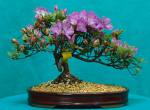Recommended Indoor Bonsai Trees
In my previous post I discussed how to create jin on a bonsai branch. In this post I will discuss how to create sharimiki or shari which complements jin. Sharimiki is created by stripping bark off part of the trunk. Natural sharimiki is when a tree may have been struck by lightning and part of the bark has been removed. The type of trees this is commonly seen on is junipers and pines. The basic tools needed to create sharimiki are electricians pliers and a gardening knife, however bonsai specialist tools will make the job easier. Bonsai Tools & Wire
As like creating jin the best time to creat sharimiki is in the summer when the flow of sap is greatest which makes it easier to strip the bark from the trunk of the tree. Be careful not to strip too much off the trunk as the tree depends on its bark to survive. When creating sharimiki keep in mind that you are working towards making it look natural so think about how it would look in nature such as how lightning strikes a trunk of a tree and which direction a branch would have fallen. Also you can study trees in nature that have gone through trauma. Relate what you have observed when creating sharimiki. When the sharamiki is complete you will need to wait for the exposed heartwood to dry and then treat the areas with a lime/sulpher solution to bleach and preserve the exposed wood. The color will be yellow at first, fade to white and then to a natural gray. For books on bonsai Click here
To begin creating sharimiki you need to mark the position on the trunk with a pen. The next step is to cut into the bark to the heartwood and peel back the bark from the trunk using the tip of the knife. You want to create the sharimiki so it will link to the jin or jins (bark striped off the branch). You will see hair-like fibers on the surface of the heartwood - you can burn these off with a small flame. Once the sharimiki and jin are complete the tree appears much more aged or mature. The effect you want, so pat your self on the back.





